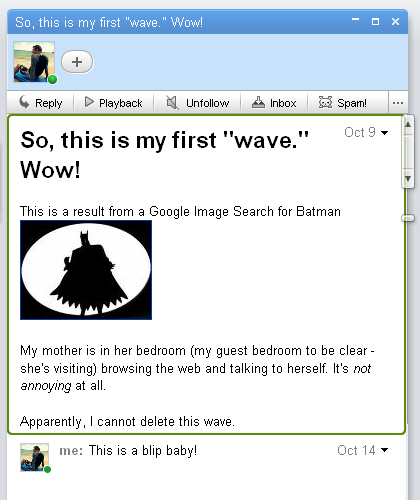My Take on Riding The Google Wave
1 Dec, 2009It’s been exactly two months since I received my Google Wave preview invitation, and began playing with the application. Here’s my take on using Wave to date – the good, the bad and yes, I have invitations for those of you who still feel like they can’t live without it.
When you first begin using Google Wave, your contacts are imported from your Gmail contacts who are also Wave Preview users. My initial contacts were obviously people I had emailed at some point, but not people whom I necessarily wanted to begin using Wave with. Because of this, my first Wave experience was rather masturbatory, and (as you can see) fairly pointless.

I was immediately given twelve Wave “invitation nominations” which I tweeted about, and promptly distributed. From this point, things started to get more interesting.
Wave as Bulletin Board
About one month into my “wavehood,” I was added to a conversation not coincidentally the topic of which was another user’s first Wave. This particular Wave included nearly 20 other users, many of which I added to my contacts list, and a flurry of activity. Overall, it was very similar to communication on an online bulletin board. Again, nothing particularly groundbreaking, but interesting to start seeing Wave in action.
The most notable feature I encountered at this point was the “Playback” button which appears above any Wave. Clicking this button chronologically replays every conversational element (adding users, blips, aka replies, etc.) allowing the user to view the Wave taking shape over time.
I started and participated in a few more Waves, varying in size and degrees of interaction, but again, the experience wasn’t much different than interacting on an online forum.
Wave as Collaboration Tool
For the most part, my initial take on Google Wave was nothing special, but I hadn’t used it with a specific purpose in mind. I decided to give Wave a try to collaborate with a colleague, Chrystie Corns (aka @ccmaine) to develop a topic and outline for an upcoming video project. Perhaps working toward a goal would shed some light on the potential for the tool?
Over the course of a week Chrystie and I traded entries, forum-style, in our Wave as we planned our video project. It wasn’t until we both participated simultaneously in the Wave that it became more interesting. The Wave experience transformed from a static forum into a more interactive instant messaging application. Again, not exceptionally innovative, but the ability to go from an asynchronous exchange to a real-time conversation is useful.
Things started to fall apart when Chrystie’s browser repeatedly crashed (irony: she was using Google Chrome), and we ended up finishing the conversation on the phone. I’m not complaining about having to pick up the phone and chat with CC, but I am curious about how Google is tracking user feedback, crash reports and errors within Wave.
Final Thoughts & Tips… oh, and Wave Invitations
I find it particularly odd that users are able to edit each other’s content within Google Wave. You can’t edit another person’s blog, forum post, email or IM conversation. Why can someone edit someone else’s content within Wave?
If you’re a Firefox user, you have to install the Google Wave notification plugin. Without a reminder letting me know about new activity in the Waves I participate in, I may have lost interest and forgotten about it altogether.
As Erick Schonfeld of TechCrunch pointed out, Wave does work as a web application on the iPhone, but, although the development team has worked hard to make the UI compatible with the mobile browser, the performance is lacking. I’d skip it for now – not ready for prime time.
Still interested? Want an invitation to Google Wave so you can try it for yourself? Leave a comment, and let me know why you want to join the Wave (I need your email address to add you to my invitation nomination list). If you are already using Wave, I’d love to hear about your experience as well.
Posted in Social Media, Technology, User Experience | 1 Comment »